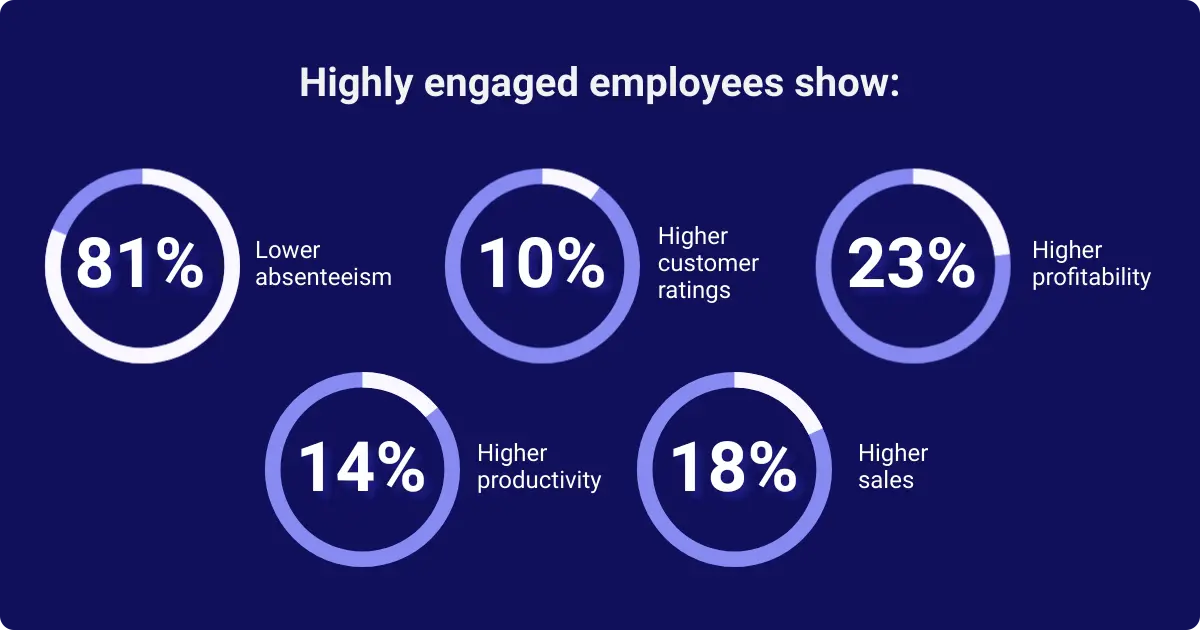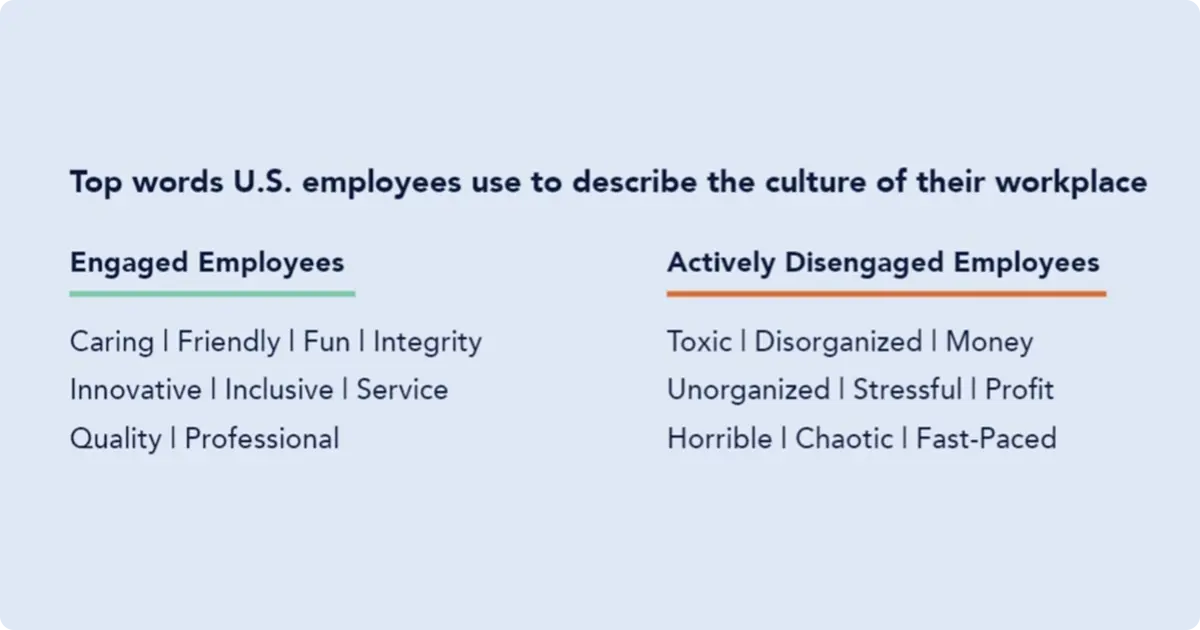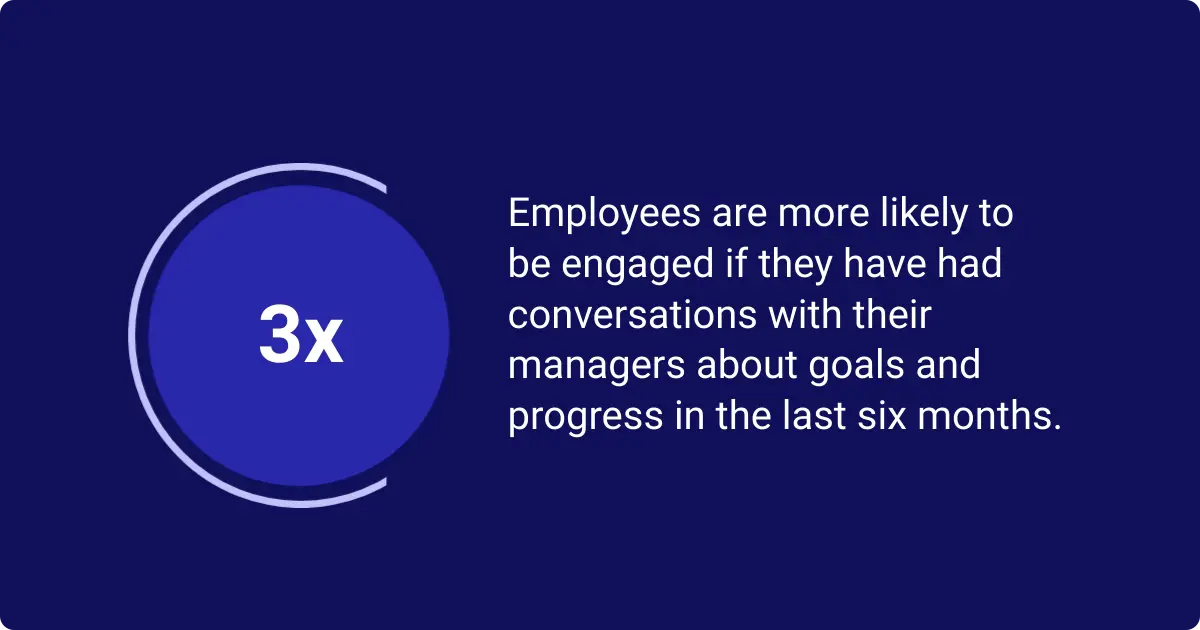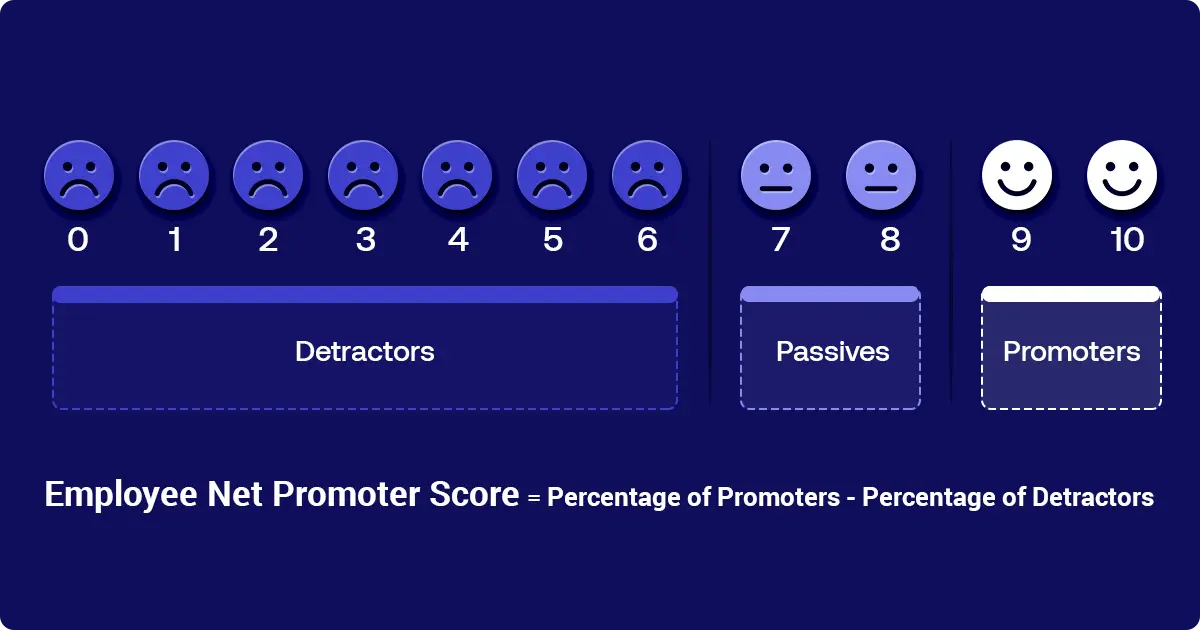How To Create an Effective Employee Engagement Action Plan

Crafting an effective employee engagement action plan involves strategic planning and clear communication. By focusing on your organization's needs and your employees' aspirations, you can drive engagement and improve overall performance. Implementing a structured action plan can significantly boost employee retention and productivity.
Understanding the key components of such a plan is crucial. From assessing current engagement levels through surveys to fostering open feedback loops, every step plays a vital role. Engaged employees are more likely to stay and contribute positively to your organization's goals.
Equipped with the right strategies, you can transform your workplace into a hub of motivation and satisfaction. Whether through employee recognition programs or opportunities for career development, every effort counts in building a vibrant and committed workforce.
Key takeaways
- Structured action plans boost employee engagement and retention.
- Regular surveys and feedback loops are essential.
- Recognition and development opportunities enhance motivation.
What is an employee engagement action plan?
An employee engagement action plan is a strategic roadmap for boosting employee engagement within a company. It outlines specific initiatives and activities for increasing employees' emotional and psychological investment in their work and the company.
The primary goal of this plan is to create a positive and motivating work environment where employees feel valued, connected, and committed to their roles and the organization’s success.
What are the benefits of creating an action plan?
An employee engagement action plan can yield numerous benefits for an organization. These benefits include improved productivity, higher employee retention, increased profitability, and a positive impact on the overall work environment. Let’s delve into the advantages of successfully implementing an employee engagement action plan.

Improved productivity and performance
Engaged employees tend to be more productive and perform at higher levels. A well-executed employee engagement action plan can improve individual and team performance, directly impacting the organization's overall success.
Happier employees
Engaged employees are happy employees, and happy employees thrive – along with the organizations of which they’re a part. As Happier founder Nataly Kogan explains, engaged and thriving employees “perform 27% better than non-thriving employees, including 89% better on innovation, and they are 79% more committed to the organization.”
This is in contrast to the 30% of disengaged American workers who are “more likely to miss work, negatively influence their co-workers, and drive customers away.”
Explore proven methods to support employee happiness in a consistent, scalable way.
Focused efforts and clear objectives
Engagement action plans provide a structured approach to addressing employee engagement issues, ensuring efforts are targeted and strategic. By setting clear, measurable objectives, organizations can track progress and determine the success of initiatives.
Improved employee morale and job satisfaction
As employees see their feedback being addressed through concrete actions outlined in the employee engagement action plan, their morale and overall job satisfaction tend to increase. They are more likely to feel valued and engaged when they witness tangible efforts to enhance their work experience.
Data-driven decision-making
An action plan empowers HR leaders with tools for data-driven decision-making, enabling them to identify key focus areas, allocate resources efficiently, and track progress effectively.
Increased return on investment (ROI)
Engaged employees are more productive, resilient, and less likely to leave, reducing turnover, absenteeism, and low productivity costs. This increases the ROI of employee engagement initiatives.
Higher employee retention
Engaged employees are more likely to stay with the company. An action plan focused on improving engagement can reduce turnover. According to a study by GallupOpens in a new tab, teams that score in the top 20% in engagement realize a 41% reduction in absenteeism and 59% less turnover.
According to 'The Relationship Between Engagement at Work and Organizational OutcomesOpens in a new tab', a 2012 analysis of 263 research studies covering 192 companies, organizations with the most engaged employees have 65% lower turnover compared to those with the least engaged employees.
Positive workplace culture
In a recent Workforce survey, employed members of the Gallup Panel were asked to describe their work culture in three short words or phrases. Engaged employees were more likely to use words such as “caring,” “innovative,” and “inclusive,” whereas actively disengaged employees were more likely to use words such as “toxic,” “disorganized,” and “chaotic.”
Find out how strategic recognition can save your organization more than $90 million in gained employee productivity. Download the Gallup-Workhuman report to see 3 ways recognition improves business outcomes.

A step-by-step guide to creating employee engagement action plans
1. Assessment and analysis
Begin by assessing the current state of employee engagement within your organization. This involves measuring employee engagement to identify areas of strength and opportunities for improvement. This can include:
- Conducting surveys to gather employee feedback.
- Analyzing the data to identify areas that need improvement and understand specific challenges.
Conducting employee engagement surveys
Employee surveys help organizations better understand their workforce. They enable you to gather essential data and create actionable plans. To get valuable information from employees, design surveys that align with your business goals. Clear, concise employee survey questions ensure you gather relevant insights. Use both quantitative and qualitative questions to capture varied feedback.
Timing is crucial. Conduct surveys when employees can reflect on their experiences. Make participation easy and anonymous to encourage honesty. Regularly updated surveys help track changes in engagement and satisfaction over time.
Analyzing employee engagement survey results
Once you collect employee survey results, analyze the data thoroughly. Look for trends and patterns that highlight areas needing improvement. Use software tools to break down the data by department, location, or job role.
Identify key metrics such as employee satisfaction, engagement levels, and areas of concern. Communicate findings to relevant teams and create targeted action plans to address identified issues. This approach ensures that the survey data leads to practical improvements.
2. Identify targeted initiatives
Once you’ve assessed the current state of employee engagement and set clear objectives, it’s time to identify targeted initiatives that address the specific issues uncovered in your analysis. Here’s a more detailed look at potential initiatives:
Training programs
- Skill development: Offer courses and workshops that help employees develop new skills or enhance existing ones. This not only boosts engagement but also increases productivity and job satisfaction.
- Leadership training: Train current and aspiring leaders to ensure they are well-equipped to support and motivate their teams effectively.
- Onboarding programs: Implement comprehensive onboarding programs for new hires to ensure they feel welcomed and supported from day one.
Recognition and rewards plan
- Peer-to-Peer recognition: Implement peer recognition systems that allow employees to acknowledge each other’s contributions.
- Managerial recognition: Ensure managers regularly acknowledge and reward their team members’ hard work through verbal praise, awards, and incentives.
- Formal rewards program: Develop a structured employee recognition program with regular rewards for outstanding performance, innovation, and teamwork.
Wellness programs
- Physical health: Offer initiatives that promote physical well-being, such as gym memberships, yoga classes, and health screenings.
- Mental health: Provide resources for mental health support, including counseling services, stress management workshops, and mental health days.
- Work-Life balance: Implement flexible working hours, remote work options, and generous leave policies to encourage a healthy work-life balance.
See also: Boosting Employee Engagement in Healthcare
Changes in work processes
- Workflow improvements: Review and streamline existing workflows to eliminate inefficiencies and reduce employee frustration.
- Technology upgrades: Invest in modern tools and technologies that facilitate better collaboration and productivity.
- Autonomy and empowerment: Empower employees by giving them more control over their work processes and decision-making responsibilities.
Additional considerations
When identifying initiatives, it's crucial to:
- Involve employees: Engage employees in selecting and designing initiatives to ensure they meet their needs and preferences.
- Align with company culture: Ensure the initiatives align with your company’s culture and values to foster a cohesive and supportive work environment.
- Prioritize initiatives: Focus on initiatives that address the most critical engagement issues first and have the potential for the most significant impact.
- Pilot programs: Consider starting with pilot programs to test the effectiveness of new initiatives before rolling them out company-wide.
By carefully selecting and implementing targeted initiatives, you can address the specific challenges identified in your assessment, leading to a more engaged and motivated workforce.
3. Develop an action plan
Creating an effective employee engagement action plan involves setting detailed objectives, identifying key performance indicators (KPIs), and establishing a clear timeline for implementation. These steps ensure the action plan is precise and aligned with organizational goals.
Set clear objectives
Define clear and measurable objectives that align with your organization's goals. Objectives might include increasing employee productivity or reducing turnover rates. These goals should be based on employee feedback to ensure they address actual needs.
Make objectives specific and time-bound. For example, aim to increase productivity scores by 15% within six months or reduce turnover rates by 10% within a year. Clear objectives provide a targeted direction and help maintain focus throughout the process.
Create a timeline for implementation.
Develop a timeline to guide the implementation of your engagement action plan. Break down the plan into phases, each with specific milestones and deadlines.
- Set deadlines: Establish realistic deadlines for each task. Deadlines help maintain momentum and ensure the plan stays on track.
- Milestones: Identify important milestones within the timeline. These are major progress points that indicate significant achievements, such as completing initial training sessions or launching a new communication platform.
- Adjustability: While deadlines are important, build flexibility to accommodate unexpected challenges or delays. Being too rigid can lead to stress and reduced effectiveness.
4. Assign responsibilities
Determine who within the organization will be responsible for implementing each objective. This ensures accountability and clarity in execution. Clearly define what each person is accountable for, whether overseeing an engagement activity or monitoring resource allocation.
Regular check-ins and progress reports are vital. Establish a routine for updating stakeholders on the plan’s progress. To keep everyone informed, you can use team meetings, reports, or digital dashboards similar to our Conversations tool. Holding team members accountable ensures that tasks are completed and fosters a culture of commitment and responsibility.
Consider setting up a system of rewards and recognition to foster accountability. When employees see that their efforts lead to tangible results, they are more motivated to maintain their level of engagement.
5. Implement the Plan
Put the plan into action by executing the identified initiatives. Ensure that all team members are on board and understand their roles in the process by specifying the actions to be taken.
- Detail each initiative: Break down each identified initiative into specific, actionable steps. For example, one initiative could be to implement a recognition program. In that case, the steps would include researching best practices, selecting a platform, training managers on how to use the platform, and launching the program.
- Assign tasks: Clearly assign each task to a responsible person or team. Specify who will carry out each step to ensure accountability and prevent overlaps or confusion.
- Sequence tasks: Arrange tasks in a logical order. Some tasks must be completed before others can begin, so it’s essential to outline the sequence of actions to maintain a smooth workflow.
6. Communication and feedback loops
Strong communication and feedback loops are essential for improving employee engagement and ensuring the successful implementation of an action plan. This involves creating clear communication channels, fostering open feedback, and utilizing tools like pulse surveys to gauge employee sentiments.

Establish communication channels
Utilizing various communication channels to ensure employees receive the information they need is important. Options include emails, internal social media, and meetings. Each channel should serve a specific purpose.
Emails can deliver detailed plan updates. Internal social media platforms can encourage informal discussions and sharing. Meetings provide opportunities for face-to-face interactions and immediate feedback. Consistent and clear communication through these channels helps employees stay informed and involved in the company's plans.
Encourage open feedback
Encouraging open feedback is crucial to fostering a culture where employees feel valued and heard. Managers should establish an environment where feedback is welcomed and acted upon.
This can be achieved by regularly asking for employee opinions on projects and processes and ensuring there are easy and anonymous ways to give feedback. Recognition of contributions and transparent actions based on feedback can further motivate employees to share their true thoughts, enhancing the sense of ownership and engagement.
Utilize pulse surveys
Pulse surveys are a valuable tool for continuously gauging employee sentiments and identifying areas for improvement. These short, frequent surveys can provide real-time employee morale and engagement insights.
Regularly conducted pulse surveys can cover various topics, from individual satisfaction to overall team dynamics. Analyzing the results will help management take timely and effective actions. By addressing issues promptly based on survey feedback, organizations can demonstrate their commitment to employee welfare and drive engagement.
7. Regular follow-up and review
Establishing a cadence for regular follow-up and review is necessary for any successful action plan.
Continuous monitoring and adjustment help keep the plan on track and responsive to changing needs. Here’s a detailed look at how to effectively conduct follow-ups and reviews:
Conduct regular check-ins and follow-up meetings
- Scheduled meetings: Hold regular meetings with initiative leaders and implementation teams to discuss the progress of each action item. These meetings should be scheduled at consistent intervals, such as weekly or biweekly, to maintain momentum and address issues promptly.
- Progress reports: Require initiative leaders to prepare progress reports detailing completed tasks, upcoming activities, and any obstacles encountered. These reports help keep everyone informed and ensure accountability.
- Feedback mechanisms: Create opportunities for two-way communication where employees can share their thoughts and feedback, such as feedback tools, regular surveys, and open forums. Create a safe space for team members to share honest feedback, discuss challenges, and propose solutions. This transparency fosters collaboration and problem-solving. (Note: With Conversations, anyone can request and receive feedback at any time, and managers can use it to gather input and provide a more holistic view of their employees.)
Conduct periodic comprehensive reviews
- Quarterly and annual reviews: In addition to regular check-ins, more comprehensive reviews should be conducted on a quarterly and annual basis. These reviews should involve a thorough evaluation of all initiatives and their impact on overall engagement.
- Stakeholder involvement: Involve key stakeholders, including senior leaders, in these comprehensive reviews. Their insights and support are crucial for driving sustained improvements and aligning with organizational goals.
- Report findings: Prepare detailed reports summarizing the findings of these reviews. Highlight successes, lessons learned, and recommended adjustments. Share these reports with all relevant parties to maintain transparency and accountability.
9. Track and measure progress
To ensure its effectiveness, it's crucial to track and measure the success of your employee engagement action plan. Key Performance Indicators (KPIs) and engagement metrics help you track progress and measure the success of your engagement action plan.
Additionally, it's important to measure employee performance to gain a comprehensive understanding of how engagement impacts productivity and overall success.
Engagement metrics and KPIs
Using well-defined engagement metrics and KPIs can help you gauge the effectiveness of your strategies. Standard metrics include employee satisfaction scores, engagement scores, turnover rates, and attendance.
Use a mix of qualitative and quantitative KPIs. For instance, track the number of employees involved in engagement initiatives and gather feedback through surveys and focus groups.
Surveys can provide insights into how employees feel about their work environment. Regularly analyzing these data points helps identify trends and areas needing improvement.
To measure the impact of your initiatives, compare current metrics with baseline data collected before implementing the action plan. This comparison will highlight any significant changes and pinpoint areas that require further attention.
Utilizing dashboards and project management tools can help visualize progress and trends. These tools offer real-time data, making tracking key performance indicators easier and ensuring your employee engagement strategies are on the right path.
Employee Net Promoter Score (eNPS)
The Employee Net Promoter Score (eNPS) is a valuable tool for measuring loyalty. It asks employees how likely they are to recommend your company as a place to work.
Responses are scored from 0 to 10. Those who score 9-10 are promoters, 7-8 are passives, and 0-6 are detractors. The eNPS is calculated by subtracting the percentage of detractors from the percentage of promoters.

A high eNPS indicates strong employee engagement and satisfaction. Regularly monitoring eNPS can highlight shifts in sentiment and inform engagement strategies.
Conclusion
Creating an effective employee engagement action plan is an ongoing process that requires commitment and regular evaluation. You can significantly boost employee engagement and retention by setting clear goals, conducting surveys, analyzing results, and establishing measurable initiatives.
Remember, providing recognition and development opportunities further enhances motivation. Take these key takeaways and start crafting your action plan to foster a more engaged and productive workplace.
About the author
Ryan Stoltz
Ryan is a search marketing manager and content strategist at Workhuman where he writes on the next evolution of the workplace. Outside of the workplace, he's a diehard 49ers fan, comedy junkie, and has trouble avoiding sweets on a nightly basis.